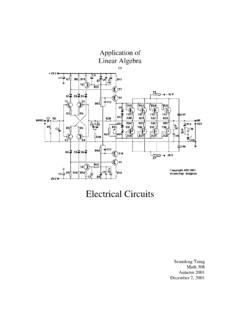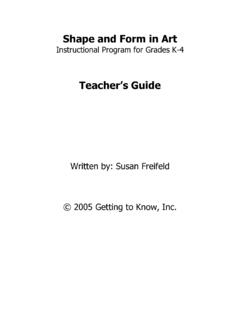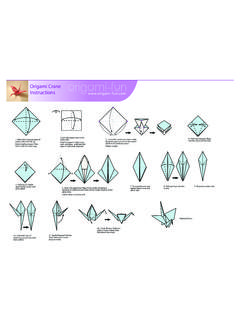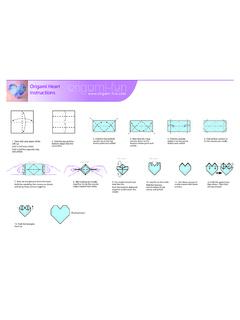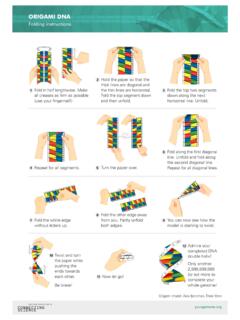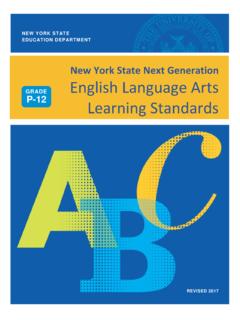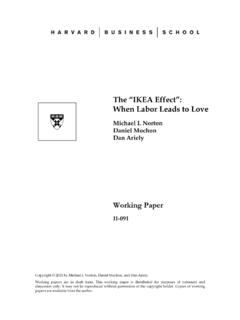Transcription of The Mathematics of Origami - University of Washington
1 The Mathematics of Origami Sheri Yin June 3, 2009. 1. Contents 1 Introduction 3. 2 Some Basics in Abstract Algebra 4. Groups .. 4. Ring .. 4. Field .. 5. Polynomials .. 5. 3 Properties of Origami 7. Basic Constructions .. 7. Origami Numbers .. 9. 4 Possible Origami Constructions 11. 5 The Complete Axioms of Origami 13. 6 Conclusion 16. 2. 1 Introduction Origami is a type of art first originated from Japan. It is possible to fold many beautiful shapes in Origami . Most amazingly, many astonishing pieces of Origami are produced from a single piece of paper, with no cuttings. Just like constructions using straight edge and compass, constructions through paper folding is both mathematically interesting and aesthetic, particularly in Origami . Some of the different categories of Origami are presented below: Modular Origami Origami Tessellation Origami Animal 3. There are many other beautiful shapes that can be constructed through paper folding.
2 Surprisingly, it turns out that Origami is much more powerful than straight-edge and compass creations, because many things that cannot be cre- ated using straight-edge and compass, such as the doubling of a cube and tri- section of an angle, can be created through paper folding [3]. This result turns out to be quite unexpected, because we can only fold straight lines in Origami due to the fact that curves are completely arbitrary in folding. Since the study of Origami is fairly recent, there is no limit yet to the type of constructions that can be formed through paper folding. The focus of this paper will be on deciding what kind of shapes are possible to construct using Origami , and what kind of shapes are not. It will be mainly based on David Auckly and John Cleveland's article, Totally Real Origami and Impossible Paper Folding . Since we have yet to discover a boundary in the cre- ation of Origami , Auckly and Cleveland gave a limited definition of Origami in their paper.
3 Although this limited definition excludes those properties of Origami that made them exceptionally powerful, Auckly and Cleveland man- aged to find a way of determining which constructions are possible from the given points and lines using this new definition. In this paper, we will first take a look at what is constructible under the definition of Origami given by Auckly and Cleveland, and then inspect those other axioms of Origami that make them powerful. 2 Some Basics in Abstract Algebra Before getting into Origami , we need to develop a set of definitions needed to understand the algebra in Auckly and Cleveland's paper. Groups Definition A group is a set G together with a multiplication on G which satisfies three axioms: a) The multiplication is associative, that is to say (xy)z = x(yz) for any three (not necessarily distinct) elements from G. b) There is an element e in G, called an identity element, such that xe =.
4 X = ex for every x in G. c) Each element x of G has a (so-called) inverse x 1 which belongs to the set G and satisfies x 1 x = e = xx 1 . Definition An abelian group is a group G such that for all x, y G, xy = yx. (In this case, xy has an invisible operator, which could either be x + y or x y, but not both at the same time). Definition A symmetric group, Sn , is the set of the permutations of n elements {x1 , .. , xn }. 4. Let us look at an example of symmetric group. List notation is used to describe a set, {[s1 ], [s2 ], .. , [sn ]}, where s1 , .. , sn are the elements of the set. Using list notation, we can express the symmetric group of the elements {x1 , x2 , x3 }: S3 = {[x1 , x2 , x3 ], [x1 , x3 , x2 ], [x2 , x1 , x3 ], [x2 , x3 , x1 ], [x3 , x1 , x2 ], [x3 , x2 , x1 ]}. This set is consisting of all permutations of {x1 , x2 , x3 }. Ring Definition A ring R is a set, whose objects can be added and multiplied, ( we are given associations (x, y) x + y and (x, y) xy from pairs of elements of R, into R), satisfies the following conditions: [4].
5 A) Under addition, R is an additive, and abelian group. b) For all x, y, z R, we have x(y + z) = xy + xz and (y + z)x = yx + zx c) For all x, y, z R, we have associativity (xy)z = x(yz). d) There exists an element e R such that ex = xe = x for all x R, where e is the identity element. An example of a ring is the set of integers, Z, because addition is commu- tative and associative, and multiplication is associative. For any three integers x, y, z, we have x(y + z) = xy + xz and (y + z)x = yx + zx. In addition, let the multiplicative identity e = 1, then 1 x = x 1 = x x R. Therefore, the set of integers form a ring. Field Definition A commutative ring such that the subset of nonzero elements form a group under multiplication is called a field. [4]. A field is essentially a ring that allows multiplication to be commutative, after removing the zero element. For a field, everything other than the zero element must have an inverse.
6 Otherwise it is a ring. An example would be that the set of integers, Z, is not a field, but the set of rationals, Q, is a field. The reason is that integers do not have multiplicative inverse: 2 21 = 1 but 12 / Z. Matrices are not a ring or a field, because it is not commutative under multiplication. Polynomials Definition A number is an algebraic number if it is a root of a poly- nomial with rational coefficients. [2]. 5. Definition A polynomial p(x) in any field, F [x], is called irreducible over F if it is of degree 1, and given a factorization, p(x) = f (x)g(x), with f, g F [x], then deg f or deg g = 0. [4]. For example, consider the following polynomials: p1 (x) = x2 4 = (x + 2)(x 2). 1 1 1. p2 (x) = x2 = (x + )(x ). 4 2 2. p1 is reducible over Z[x] because both x + 2 and x 2 are polynomials over integers as well. However, p2 (x) is not reducible over Z[x]. It is, nonetheless, reducible over Q [x], because both of the factored polynomials are polynomials over Q.
7 Remark: Any algebraic number, , could be expressed as a root of a unique irreducible polynomial in Q [x], denoted by p (x). This polynomial p (x) will divide any polynomial in Q [x] that has as a root. Definition The conjugates of are the roots of the polynomial p (x). An algebraic number is totally real if all of its conjugates are real. We denote the set of totally real numbers by F T R . [2]. p . To make sense of the previous section, consider the number, 5 + 2 2. It is an algebraic number, since it could be expressed as a unique irreducible ppolynomial . in Q [x]. The other roots of this polynomials are its conjugates: 5 2 2. We can see that these numbers form a unique polynomial in Q : . q q q q . x+ 5+2 2 x 5+2 2 x+ 5 2 2 x 5 2 2. = x4 10x2 + 17. which is a polynomial with rational p coefficients. Additionally, since all the p . conjugates of 5 + 2 2 are real, 5 + 2 2 is totally real. Additionally, the polynomial above, p = x4 10x2 + 17, is the unique irreducible polynomial, p.
8 Which will divide any polynomials p in Q [x] that contains 5 + 2 2 as its root. On the other hand, the number 1 + 2 is not totally real, because two of its p . conjugates, 1 2 , are imaginary. The last topic we will go over is symmetric polynomials. We have already defined symmetric group. The following is definition for symmetric polynomi- als: Definition Let R be a ring and let t1 , .. , tn be algebraically independent elements over R. Let x be a variable, and let G be a symmetric group on n 6. letters. Let be a permutation of integers (t1 , .. , tn ). Given a polynomial f (t) = R[t1 , .. , tn ], we define f to be: f (t1 , .. , tn ) = f (t (1) , t (2) , .. , t (n) ). A polynomial is called symmetric if f = f for all G. [4]. For example, let f (t1 , t2 ) = t21 t22 . This is not a symmetric polynomial, because we can let : t1 7 t2 , : t2 7 t1 : t22 t21 6= t21 t22 = f 6= f. However, t21 + t22 is a symmetric polynomial, because t21 + t22 = t22 + t21.
9 Knowing the definition for symmetric polynomial, let's take a look at the fol- lowing polynomial: p(x) = (x t1 )(x t2 ) (x tn ). = xn s1 xn 1 + + ( 1)n sn where each sj is given as: s1 = t1 + t2 + + tn sj = the sum of all products of j distinct tk 's sn = t1 t2 tn . The polynomials, sj (t1 , .. , tn ), 1 j n are called the elementary symmetric polynomials of t1 , .. , tn . [4]. Another way to express that is: n Y n X. (x tk ) = ( 1)j sj (t1 , .. , tn )xn j (1). k=1 j=0. For example, expanding (x t1 )(x t2 )(x t3 ), we have: (x t1 )(x t2 )(x t3 ) = x3 (t1 + t2 + t3 )x2 + (t1 t2 + t2 t3 + t1 t3 ) t1 t2 t3. All the following polynomials, s1 = t1 + t2 + t3. s2 = t1 t2 + t2 t3 + t1 t3. s3 = t1 t2 t3. are elementary symmetric polynomials. Now we are done introducing the definitions in abstract algebra that would occur in this discussion of the paper folding. We can now start looking at some properties of Origami .
10 7. 3 Properties of Origami Basic Constructions In order to understand Origami construction, we will need to understand some of the most basic folds that can be created. The following is the definition given by Auckly and Cleveland of Origami pair. This definition is the basis of what we mean by Origami in this paper: Definition {P, L} is an Origami pair if P is a set of points in R2 and L is a collections of lines in R2 satisfying: a) The point of intersection of any two non-parallel lines in L is a point in P. b) Given any two distinct points in P, there is a line L going through them. c) Given any two distinct points in P, the perpendicular bisector of the line segment with given end points is a line in L. d) If L1 and L2 are lines in L, then the line which is equidistant from L1 and L2 is in L. e) If L1 and L2 are lines in L, then there exists a line L3 in L such that L3. is the mirror reflection of L2 about L1.

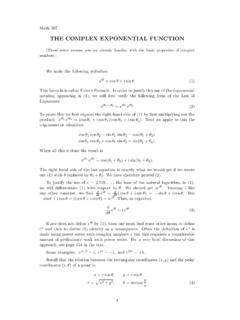

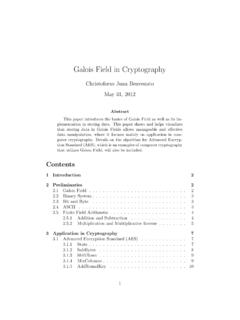

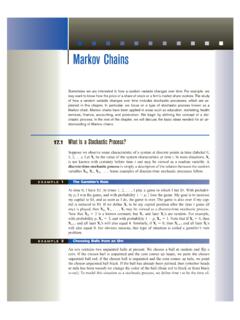
![ZZ dA R [0 2] R - University of Washington](/cache/preview/6/4/c/c/9/f/d/6/thumb-64cc9fd6ac93e2995c04a2a74b217176.jpg)


